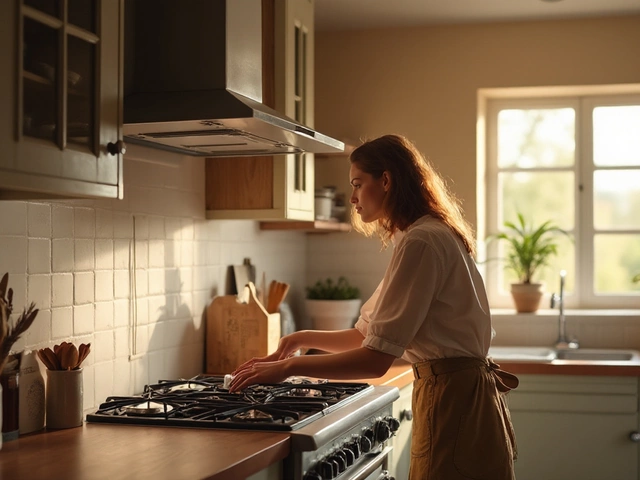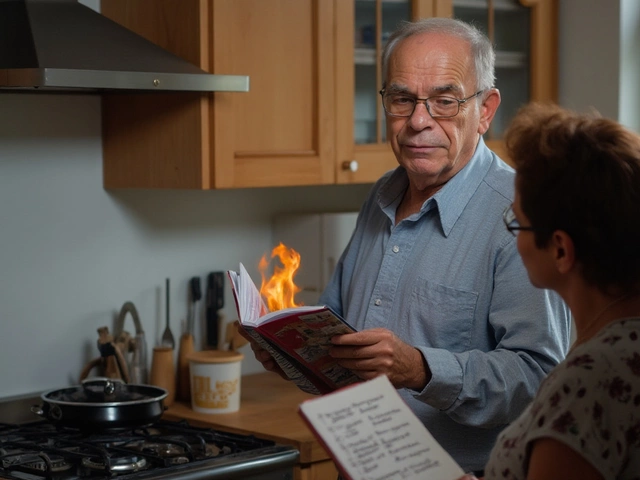Electric stoves are pretty much the unsung heroes of modern kitchens. They're everywhere, helping you whip up everything from a simple weekday dinner to a fancy holiday spread. But what happens when they throw in the towel and stop working? First of all, don't panic. Often, issues with electric stoves are fixable, sometimes even without needing to call in the cavalry of repair professionals.
Let's knock it down to basics. Electric stoves operate on simple principles: they use electrical heating elements to cook food. Problems can arise from wiring issues, faulty elements, bad sockets, or even something as simple as a loose connection. Sounds complicated? It's not as tricky as it seems once you get the hang of a few troubleshooting techniques. Understanding these core elements can immensely help when determining if something's worth fixing or replacing.
- Understanding the Basics
- Common Problems to Watch For
- Troubleshooting Tips
- When to Call a Professional
- Cost vs. Replacement
- Maintenance Tips to Prevent Repairs
Understanding the Basics
Before diving into fixing your electric stove, it's crucial to get your head around how these kitchen workhorses function. Electric stoves, unlike their gas counterparts, rely on electricity to heat up metal coils or elements. These coils glow red-hot and transfer heat to your pots and pans.
Now, let's consider the anatomy of an electric stove. The main components include the heating elements, control switches, thermostats, and wiring. The heating elements do the cooking part, the control switches regulate the heat level, and the thermostats ensure that temperatures stay consistent. So, issues usually pop up with one or more of these parts.
"Troubleshooting electric stove issues often requires understanding the key components," says electrical technician Max Turner. "Once you know what each part does, spotting where the problem might be becomes a lot easier."
Heating Elements
When an electric stove isn’t heating properly, the first suspect is usually the heating element. It's a metal coil that electricity runs through to create heat. If a coil doesn't glow red when you turn it on, it's either busted or has a loose connection.
Control Switches and Thermostats
Control switches allow for adjusting the heat settings. If your stove can only reach one temperature or doesn't respond when you turn the dial, these switches could be at fault. Similarly, if your oven fails to maintain a steady temperature, the thermostat might need some attention.
- Check if the heating element is sitting firmly in its socket. Sometimes a little wiggle fixes the issue.
- Control switches often have simple controls that can wear out with use, requiring replacements.
- A faulty thermostat might need professional testing and recalibration.
It's also worth ensuring your stove is plugged in tight and the circuit hasn't tripped. Sometimes, a simple reset does wonders. Equipped with this understanding, tackling common electric stove repair issues doesn't seem too daunting, right?
Common Problems to Watch For
Electric stoves are trusty appliances, but they're not without their share of hiccups. Knowing what goes wrong can save you a lot of headaches (and money). Here are a few common issues you might run into with your electric stove.
Heating Element Failures
The most glaring sign something's amiss is when the stove just doesn't heat up. This often boils down to a bad heating element. You might notice visible burns or breaks in them. The fix? It's usually as easy as swapping out the broken element for a new one.
Funky Burner Behaviors
Ever watched your stove's burners struggle to maintain a consistent temperature? They might overheat or not heat at all. This can often be traced back to a faulty infinite switch or simmer control switch, the parts responsible for channeling electricity to the burner.
Electric Oven Isn't Heating Properly
If your electric oven behaves more like a storage cabinet than a cooking appliance, the problem could lie with the bake or broil elements. You can test this by preheating your oven and seeing if it gets hot. If not, it’s worth checking these elements for visible damages or using a multimeter to test for continuity.
Strange Cooking Odors
Alright, burning food smells are normal, but what about those mysterious metallic or chemical smells? They could be a sign of electrical issues within your stove. Never ignore them, as they can indicate a safety hazard that might need professional attention.
Control Panel Malfunctions
If your stove's control panel is as responsive as a brick, you've got a problem. This issue can range from broken buttons to a faulty touchpad. Quite often, these need a replacement to get your cooking back in action.
Electrical Faults
Sometimes it's not the stove but the power source. Check your circuit breaker if the stove keeps tripping it. If your stove has power but isn't functioning, a fuse might have blown, which you can replace with the right match from your local hardware store.
| Problem | Potential Cause | Solution |
|---|---|---|
| Inconsistent Burner Heat | Faulty switch | Replace switch |
| Oven Not Heating | Broken elements | Repair/replace elements |
| Control Issues | Defective panel | Replace touchpad |
Understanding these common problems can help you decide whether you're handling a small hiccup or a heavier issue needing professional repair. Always remember, safety first. When in doubt, don't hesitate to call an expert.
Troubleshooting Tips
Okay, let's roll up our sleeves and dive into some troubleshooting for your electric stove repair. This can save you lots of time and money, and maybe even make you feel like a kitchen wizard. If your electric oven has gone rogue, these pointers might just do the trick.
Check the Power Supply
First things first, make sure your stove is actually plugged in. Sounds ridiculous, but it's always good to start simple. Also, check your circuit breaker – if it's tripped, your stove won't get any power. Resetting it can sometimes be all you need.
Inspect the Heating Elements
If your stove's burners aren't heating up, it could be a bum heating element. Have a look to see if they're properly connected. They usually plug into a socket under the stove top, so a simple reattachment might fix it. Watch out for visible damage like blisters or cracks – that means it's time for a replacement.
Test the Outlet Voltage
Ensure the outlet is delivering the right voltage. You can do this with a multimeter. Electric stoves need a 240-volt outlet. If it's delivering something else, you may need an electrician to resolve this problem.
Check the Oven Temperature Sensor
If your food is cooking unevenly, the sensor might be out of whack. It should be properly positioned against the oven wall. An out-of-place or faulty sensor can send wrong messages to the oven's brain.
Reset the Stove
Some problems are as simple as a little digital hiccup. Try resetting your stove. Unplug it for five minutes, then plug it back in. This can resolve certain glitches and brings your stove back to its senses.
| Common Issues | Potential Fix |
|---|---|
| Burners not heating | Check connection, inspect for damage |
| Oven not heating | Verify heating element, reset circuit breaker |
| Uneven cooking | Adjust or replace temperature sensor |
Remember, always be cautious when dealing with electrical appliances. If you're ever in doubt or the problem seems beyond your DIY skills, call a professional. It's better to be safe and get expert help with more complex issues.

When to Call a Professional
So, when do you throw in the towel and call for backup with your electric stove repair? Knowing when to bring in the pros can save you time, money, and a potential safety hazard.
Signs It's Time for Professional Help
First, let’s talk about signs that scream, “Don’t DIY this!” If your stove has electrical issues like continuous tripping of the breaker, visible smoke, or a persistent burning smell, it's time to call in the experts. Messing with electricity can be dangerous, so it’s best to err on the side of caution.
Also, if your stove isn’t heating properly despite your best efforts with the obvious troubleshooting (think burner swaps or resetting the power), a professional might need to dig deeper.
Complex Problems
Ever opened up a stove panel and felt like you’re staring into the matrix? Don’t worry; you’re not alone. If internal components like wiring, control boards, or thermostats are involved, these are tricky to fix without the right know-how.
- Faulty wiring: These are best left to the professionals to avoid any fire hazards.
- Control board issues: Professionals have the right tools and skills to diagnose these electronic components.
- Strange noises: Grinding or whirring sounds could indicate serious mechanical issues.
Cost versus Safety
While fixing things yourself can save a buck, sometimes calling a professional can ultimately be cheaper, not to mention safer. Specialists have access to parts, tools, and the training to get your electric oven issues sorted without a hitch. Remember, keeping your family safe always takes the front seat.
| Problem | DIY or Pro? |
|---|---|
| Tripped breaker | Professional |
| Heating element replacement | DIY |
| Smoke or burning smell | Professional |
| Control board | Professional |
In a nutshell, if you're scratching your head or smelling something odd, it's probably time to call in a pro. These folks deal with electric oven issues all the time, and they've likely seen your problem a million times before.
Cost vs. Replacement
So, you’re standing there with a suspiciously cold stove and a mounting sense of frustration—do you fix it or replace it? It’s a big decision, and one without a straightforward answer. Generally, whether you ‘repair or replace’ depends on a couple of factors like the severity of the issue, cost implications, and the age of your electric stove.
Repair Costs can vary widely. A simple fix, like replacing a faulty thermostat, could set you back around $100 to $200. However, if the issue involves major parts like the control board or multiple elements, you’re potentially looking at $300 or more. Figuring out these costs is your starting point.
Age of Your Stove
If your stove's seen more than its fair share of cooking marathons, it might be time to weigh the cost of ongoing repairs against the price of a shiny new one. After a decade, even well-maintained electric stoves can start acting up frequently; parts wear down over time.
Replacement Considerations
A new electric stove could cost anywhere from $400 for a basic model to well over $2,000 for something fancy with all the bells and whistles. Considering this investment, if repair costs start creeping above half the price of a new unit—and especially if your stove is quite old—it may be in your interest to think about replacement.
A Quick Comparison
| Repair Option | Indicative Cost |
|---|---|
| Minor Repairs (e.g., thermostat) | $100-$200 |
| Major Repairs (e.g., control board) | $300+ |
| Replacement | $400-$2,000+ |
Deciding between repairing your electric stove or getting a new one can be a balancing act. Always weigh each side—consider how often the stove has broken down, the cost of individual repairs, and how long you can reasonably expect it to keep working well. Sometimes, if repairs are minor and sparse, keeping your trusty stove might make sense fiscally and environmentally!
Maintenance Tips to Prevent Repairs
Want to keep your electric stove running smoothly without unexpected hiccups? Regular maintenance is key. Here are some down-to-earth tips you can follow.
Regular Cleaning
Seems obvious, right? But you'd be surprised how many issues come from simply not keeping the stove clean. Wipe down your electric stove after each use. Focus on the burners and elements, as food spills can cause them to malfunction.
- Use a gentle cleaner suitable for electric stoves.
- Avoid harsh scrubbers that might damage the surface.
- Make sure all connections and elements are free from debris.
Check the Connections
Nothing too technical here. Pretty much a simple check of plug sockets and power connections now and then. Electric stove connections should be secure; any looseness can lead to problems.
- Ensure the power cord is securely plugged in.
- If you move the stove, ensure it doesn't damage cords or connections.
Inspect the Heating Elements
Every few months, take a quick look at the heating elements. They should be even and free of cracks or breaks. If they appear damaged, better to swap them out before they fail during your next meal.
Inspect the Oven Door Seal
The oven door seal helps keep heat inside the oven, which is crucial for efficient cooking. If the seal's worn or broken, your stove will have to work harder, potentially leading to bigger issues.
- Close the oven door on a piece of paper. If you can slide the paper out easily, the seal might need replacing.
Consistent maintenance can save you a lot of those 'why now?!' moments. Keep your electric stove in tip-top shape with these no-nonsense tips, and you're way less likely to end up needing major electric stove repair work.





